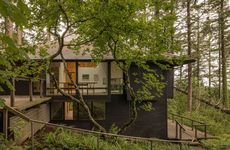This is a photo of the new Denver of Museum of Art. Designed by NYC architect Daniel Libeskind, the Museum features sharp edges and a bold exterior that will surely make it an architectual landmark.
From Philly.com:
Libeskind's museum, which was designed with the Denver-based Davis Partnership, exudes the swaggering confidence of a city on the rise. The $75 million building is Denver's latest addition to the cultural campus, which includes Ponti's turreted fortress and Michael Graves' central library from the mid-'90s, a masonry building that is as imposing, and as suffocating, as heavy drapes. It is tempting to dismiss these three architectural icons as the trophy collection of a nouveau-riche burg, but Libeskind's lilting geometry and sophisticated spatial volumes save the day.
In contrast with its ponderous, earthbound neighbors, his museum looks ready for a springy takeoff. But it is Libeskind's sure-handed site planning - a quality that New Yorkers never fully appreciated - that forces the self-involved beauty contestants to behave in a collegial and civic way. That Libeskind's museum achieves such a degree of urban grace, without forcing itself into a background role, is an achievement.
Sharp Architecture
The New Denver of Museum of Art
Trend Themes
1. Bold Architecture - The sharp edges and confident exterior of the new Denver Museum of Art showcase the trend towards bold architectural designs.
2. Urban Grace - The museum's site planning demonstrates the trend towards achieving urban grace through architectural design.
3. Spatial Volumes - Libeskind's sophisticated spatial volumes highlight the trend towards creating visually stunning and functional interior spaces.
Industry Implications
1. Architecture - The bold and innovative architectural design of the Denver Museum of Art presents disruptive innovation opportunities in the architecture industry.
2. Cultural Tourism - The new museum's unique and striking design is likely to attract tourists, suggesting disruptive innovation opportunities in the cultural tourism industry.
3. Urban Planning - The successful site planning of the museum presents disruptive innovation opportunities in the field of urban planning, by showcasing how architecture can enhance the overall urban environment.




